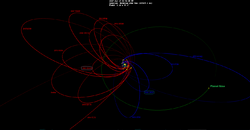Astronomy:(148209) 2000 CR105
 2000 CR105 is seen as a smaller orbit center left in red with hypothetical Planet Nine in green | |
| Discovery[1] | |
|---|---|
| Discovered by | Marc W. Buie |
| Discovery date | 6 February 2000 |
| Designations | |
| 2000 CR105 | |
| Minor planet category | |
| Orbital characteristics[2][4] | |
| Epoch 13 January 2016 (JD 2457400.5) | |
| Uncertainty parameter 2 | |
| Observation arc | 5547 days (15.19 yr) |
| Earliest precovery date | 6 February 2000 |
| |{{{apsis}}}|helion}} | 411.62 astronomical unit|AU (61.577 Tm) (Q) |
| |{{{apsis}}}|helion}} | 44.286 AU (6.6251 Tm) (q) |
| 227.95 AU (34.101 Tm) (a) | |
| Eccentricity | 0.80572 (e) |
| Orbital period | |
| Average Orbital speed | 1.63 km/s |
| Mean anomaly | 5.28267° (M) |
| Mean motion | 0° 0m 1.031s / day (n) |
| Inclination | 22.71773° (i) |
| Longitude of ascending node | 128.24627° (Ω) |
| 317.219° (ω) | |
| Physical characteristics | |
| Dimensions | |
| Geometric albedo | 0.04 (expected)[5] |
| Physics | ~ 19 K |
| Apparent magnitude | 23.8[8] |
| Absolute magnitude (H) | 6.3[4] |
(148209) 2000 CR105 is a trans-Neptunian object and the tenth-most-distant known object in the Solar System (As of 2015). Considered a detached object,[9][10] it orbits the Sun in a highly eccentric orbit every 3,305 years at an average distance of 222 astronomical units (AU).[4]
Description
Mike Brown's website lists it as a possible dwarf planet with a diameter of 328 kilometres (204 mi) based on an assumed albedo of 0.04 .[5] The albedo is expected to be low because the object has a blue (neutral) color.[5] However, if the albedo is higher, the object could easily be half that size.
(148209) 2000 CR105 and Sedna differ from scattered-disc objects in that they are not within the gravitational influence of the planet Neptune even at their perihelion distances (closest approaches to the Sun). It is something of a mystery as to how these objects came to be in their current, far-flung orbits. Several hypotheses have been put forward:
- They were pulled from their original positions by a passing star.[11][12]
- They were pulled from their original positions by a very distant, and as-yet-undiscovered (albeit unlikely), giant planet.[13]
- They were pulled from their original positions by an undiscovered companion star orbiting the Sun such as Nemesis.[13]
- They were captured from another planetary system during a close encounter early in the Sun's history.[11] According to Kenyon and Bromley, there is a 15% probability that a star like the Sun had an early close encounter and a 1% probability that outer planetary exchanges would have happened. (148209) 2000 CR105 is estimated to be 2–3 times more likely to be a captured planetary object than Sedna.[11]
(148209) 2000 CR105 is the first object discovered in the Solar System to have a semi-major axis exceeding 150 AU, a perihelion beyond Neptune, and an argument of perihelion of 340°±55°.[14] It is one of eleven objects known with a semi-major axis greater than 100 AU and perihelion beyond 42 AU.[15] It may be influenced by Planet Nine.[16]
See also
- 474640 Alicanto
- (87269) 2000 OO67
- Clearing the neighbourhood
- Planets beyond Neptune
- List of Solar System objects most distant from the Sun
- List of Solar System objects by greatest aphelion
References
- ↑ "List of numbered minor planets". Harvard University. http://cfa-www.harvard.edu/iau/lists/NumberedMPs.html.
- ↑ 2.0 2.1 Marc W. Buie (2006-12-21). "Orbit Fit and Astrometric record for 148209". SwRI (Space Science Department). http://www.boulder.swri.edu/~buie/kbo/astrom/148209.html. Retrieved 2008-07-18.
- ↑ "Barycentric Osculating Orbital Elements for 2000 CR105". http://ssd.jpl.nasa.gov/horizons.cgi?find_body=1&body_group=sb&sstr=2000CR105. Retrieved 2016-01-25. (Ephemeris Type:Elements and Center:@0)
- ↑ 4.0 4.1 4.2 "JPL Small-Body Database Browser: 148209 (2000 CR105)". https://ssd.jpl.nasa.gov/sbdb.cgi?sstr=2000CR105. Retrieved 11 April 2016.
- ↑ 5.0 5.1 5.2 5.3 5.4 Brown, Michael E.. "How many dwarf planets are there in the outer solar system? (updates daily)". California Institute of Technology. Archived from the original on 2011-10-18. https://web.archive.org/web/20111018154917/http://www.gps.caltech.edu/~mbrown/dps.html. Retrieved 2014-02-16.
- ↑ "List of known trans-Neptunian objects". Johnston's Archive. http://www.johnstonsarchive.net/astro/tnoslist.html. Retrieved 2014-04-05.
- ↑ 7.0 7.1 Hainaut, O.R.; Boehnhardt, H.; Protopapa, S. (October 2012). "Colours of minor bodies in the outer solar system. II. A statistical analysis revisited". Astronomy and Astrophysics 546: 20. doi:10.1051/0004-6361/201219566. Bibcode: 2012A&A...546A.115H. http://adsabs.harvard.edu/cgi-bin/bib_query?bibcode=2012A&A...546A.115H. Retrieved 26 September 2019.
- ↑ "AstDys (148209) 2000CR105 Ephemerides". Department of Mathematics, University of Pisa, Italy. Archived from the original on 2011-05-26. https://web.archive.org/web/20110526231944/http://hamilton.dm.unipi.it/astdys/index.php?pc=1.1.3.0&n=2000CR105. Retrieved 2009-03-16.
- ↑ Jewitt, David; Morbidelli, Alessandro; Rauer, Heike (2007). Trans-Neptunian Objects and Comets. Saas-Fee Advanced Course. 35. Berlin: Springer. p. 86. ISBN 978-3-540-71957-1.
- ↑ Lykawka, Patryk Sofia; Mukai, Tadashi (July 2007). "Dynamical classification of trans-Neptunian objects: Probing their origin, evolution, and interrelation". Icarus 189 (1): 213–232. doi:10.1016/j.icarus.2007.01.001. Bibcode: 2007Icar..189..213L.
- ↑ 11.0 11.1 11.2 Kenyon, Scott J.; Bromley, Benjamin C. (2004). "Stellar encounters as the origin of distant Solar System objects in highly eccentric orbits". Nature 432 (7017): 598–602. doi:10.1038/nature03136. PMID 15577903. Bibcode: 2004Natur.432..598K.
- ↑ Morbidelli, Alessandro; Levison, Harold F. (2004). "Scenarios for the Origin of the Orbits of the Trans-Neptunian Objects 2000 CR105 and 2003 VB12 (Sedna)". The Astronomical Journal 128 (5): 2564–2576. doi:10.1086/424617. Bibcode: 2004AJ....128.2564M.
- ↑ 13.0 13.1 {{cite journal
External links
- Orbit Determination of 2000 CR105
- Spacecraft escaping the Solar System (Heavens-Above)
- World Book: Worlds Beyond Pluto
- (148209) 2000 CR105 at AstDyS-2, Asteroids—Dynamic Site
- (148209) 2000 CR105 at the JPL Small-Body Database
 |

